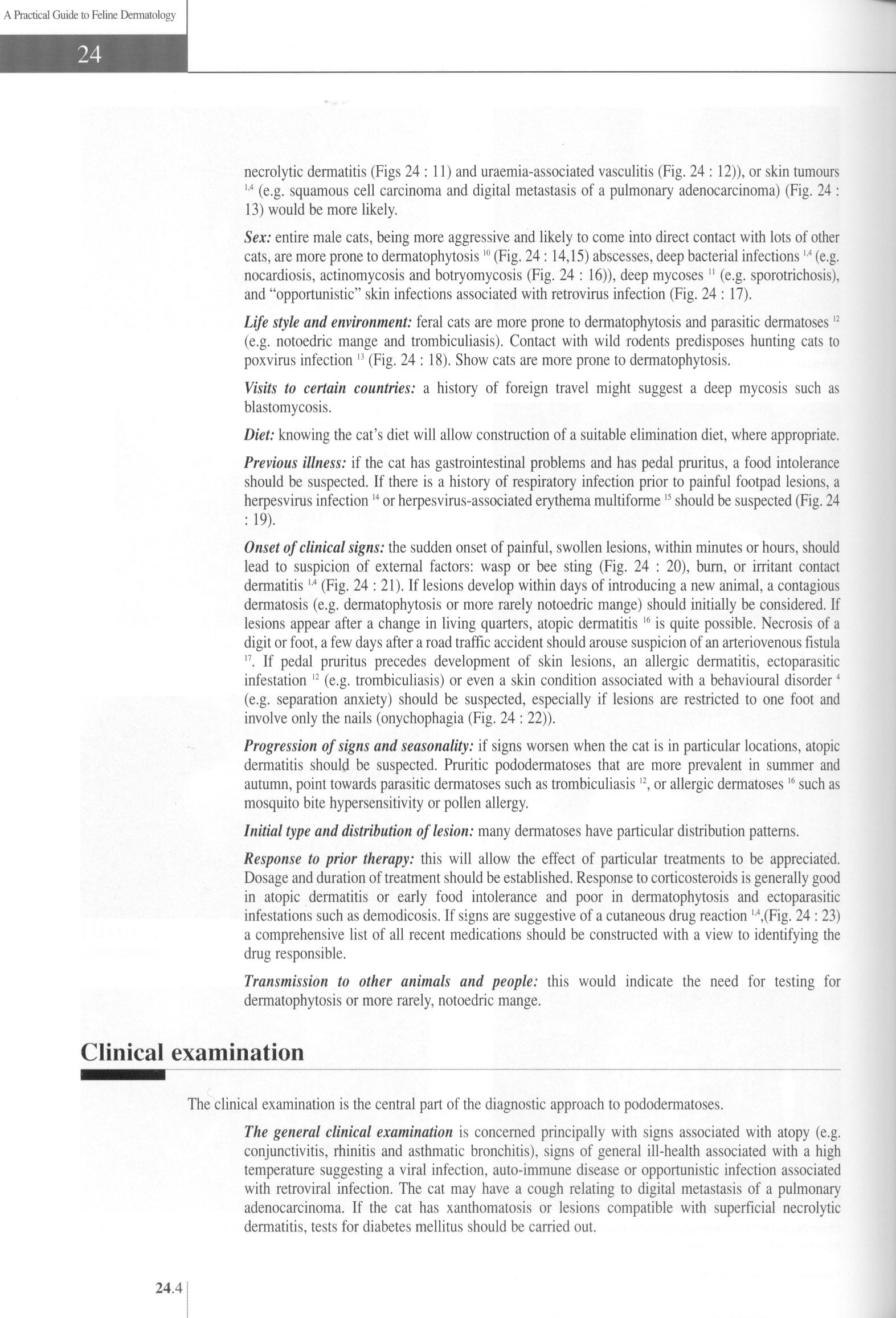244 (20)

necrolytic dermatitis (Figs 24 : 11) and uraemia-associated vasculitis (Fig. 24 : 12)), or skin tumours 1,4 (e.g. sąuamous celi carcinoma and digital metastasis of a pulmonary adenocarcinoma) (Fig. 24 : 13) would be morę likely.
Sex: entire małe cats, being morę aggressive and likely to come into direct contact with lots of other cats, are morę prone to dermatophytosis10 (Fig. 24:14,15) abscesses, deep bacterial infections1,4 (e.g. nocardiosis, actinomycosis and botryomycosis (Fig. 24 : 16)), deep mycoses " (e.g. sporotrichosis), and “opportunistic” skin infections associated with retrovirus infection (Fig. 24 : 17).
Life style and environment: feral cats are morę prone to dermatophytosis and parasitic dermatoses12 (e.g. notoedric mange and trombiculiasis). Contact with wild rodents predisposes hunting cats to poxvirus infection 13 (Fig. 24 : 18). Show cats are morę prone to dermatophytosis.
Visits to certain countries: a history of foreign travel might suggest a deep mycosis such as blastomycosis.
Diet: knowing the cat’s diet will allow construction of a suitable elimination diet, where appropriate.
Previous illness: if the cat has gastrointestinal problems and has pedał pruritus, a food intolerance should be suspected. If there is a history of respiratory infection prior to painful footpad lesions, a herpesvirus infection 14 or herpesvirus-associated erythema multiforme15 should be suspected (Fig. 24 : 19).
Onset of clinical signs: the sudden onset of painful, swollen lesions, within minutes or hours, should lead to suspicion of extemal factors: wasp or bee Sting (Fig. 24 : 20), bum, or irritant contact dermatitis14 (Fig. 24 : 21). If lesions develop within days of introducing a new animal, a contagious dermatosis (e.g. dermatophytosis or morę rarely notoedric mange) should initially be considered. If lesions appear after a change in living ąuarters, atopic dermatitis16 is quite possible. Necrosis of a digit or foot, a few days after a road traffic accident should arouse suspicion of an arteriovenous fistula l7. If pedał pruritus precedes development of skin lesions, an allergic dermatitis, ectoparasitic infestation 12 (e.g. trombiculiasis) or even a skin condition associated with a behavioural disorder4 (e.g. separation anxiety) should be suspected, especially if lesions are restricted to one foot and involve only the nails (onychophagia (Fig. 24 : 22)).
Progression of signs and seasonality: if signs worsen when the cat is in particular locations, atopic dermatitis should be suspected. Pruritic pododermatoses that are morę prevalent in summer and autumn, point towards parasitic dermatoses such as trombiculiasisl2, or allergic dermatoses16 such as mosąuito bite hypersensitivity or pollen allergy.
Initial type and distribution of lesion: many dermatoses have particular distribution patterns.
Response to prior therapy: this will allow the effect of particular treatments to be appreciated. Dosage and duration of treatment should be established. Response to corticosteroids is generally good in atopic dermatitis or early food intolerance and poor in dermatophytosis and ectoparasitic infestations such as demodicosis. If signs are suggestive of a cutaneous drag reaction M,(Fig. 24 : 23) a comprehensive list of all recent medications should be constracted with a view to identifying the drag responsible.
Transmission to other animals and people: this would indicate the need for testing for dermatophytosis or morę rarely, notoedric mange.
Clinical examination
The clinical examination is the central part of the diagnostic approach to pododermatoses.
The generał clinical examination is concemed principally with signs associated with atopy (e.g. conjunctivitis, rhinitis and asthmatic bronchitis), signs of generał ill-health associated with a high temperaturę suggesting a viral infection, auto-immune disease or opportunistic infection associated with retroviral infection. The cat may have a cough relating to digital metastasis of a pulmonary adenocarcinoma. If the cat has xanthomatosis or lesions compatible with superficial necrolytic dermatitis, tests for diabetes mellitus should be carried out.
24.4!
Wyszukiwarka
Podobne podstrony:
Davies 4 6 8 9 10 11 12 U 14 15 16 17 18 19 20 21 22 23 24 Modern farin animais and
KALENDARZ 11 (7) January M Tu W Th Fr Sa Su 1 2 3 4 5 6 7 8 9 10 11 12 13 14 15 16 17 18 19 20
jow05 08 . 13, 14, 15, and 16. 9, 10, 11. and 12. and 20. prnotlco, ln tho neralng, 5xorclaoa 5
Kuroko no Basket full 1355501 ATSUSHIMURASAKIBARA SEIJURO AKASHI 12 3 4 5 6 7 8 9 10 11 12 13 1
1 1 1 2 3 4 5 6 7 8 9 10 11 12 13 14 15 16 17 18 19 20 21 22 23 24 25 26 27 28 29 Styczeń
_ JANUARY, __ 1 2 3 4 5 6 7 8 9 10 11 12 13 14 15 16 17 18 19 20 21 22 23 24
10 pazdziernik 1 2 3 4 5 6 7 8 9 10 11 12 13 14 15 16 17 18 19 20 21 22 23 24 25 26 27 28 29 30 31 f
WT 7:30, 9:15 data 06.10 13.10 20.10 27.10 03.11 10.11 17.11 24.11 nr
040 4 Roller Blades Connect the dots from 11 to 20. Color. Don t forget your helmet and kneepads! ©
Bez nazwy 2 kopia STYCZEŃ Po Wt Sr Cz Pi So Ni 12 3 4 5 67 8 9 10 11 12 13 14 15 16 17 18&
n#n CALENBERG UUW INGENIEUREOdkształcenie 2 0 1 2 3 4 5 6 7 8 9 10 11 12 13 14 15 16 17 18 19 20 21
zmierzch kalendarz 11 31 3 1 5 6 78NK 10 11 12 13 14 15 16 17 18 19 20 21 22 23 24
statek LIPIEC Po Wt Sr Cz Pi So 1 2 3 4 5 5 78 9 10 11 12 13 14 5 6 17 18 19 20 21
swiety 2CC9 STYCZEŃ Po Wt Sr Cz Pi So Ni 12 3 4 5 67 8 9 10 11 12 13 14 15 16 17 18 1
swiiety STYCZEŃ Po Wt Sr Cz Pi So Ni 1 2 3 i 5 67 8 9 10 11 12 13 14 15 16 17 18 19 2
więcej podobnych podstron